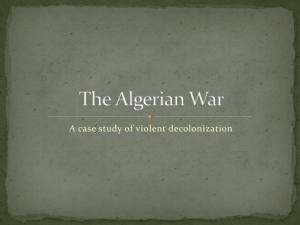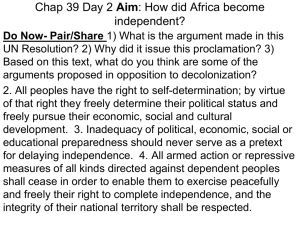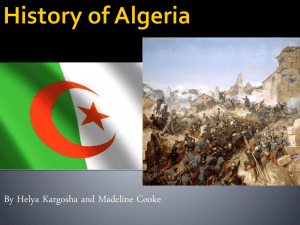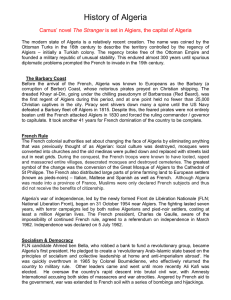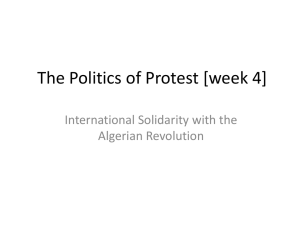A Summary of the French in the Maghreb
advertisement
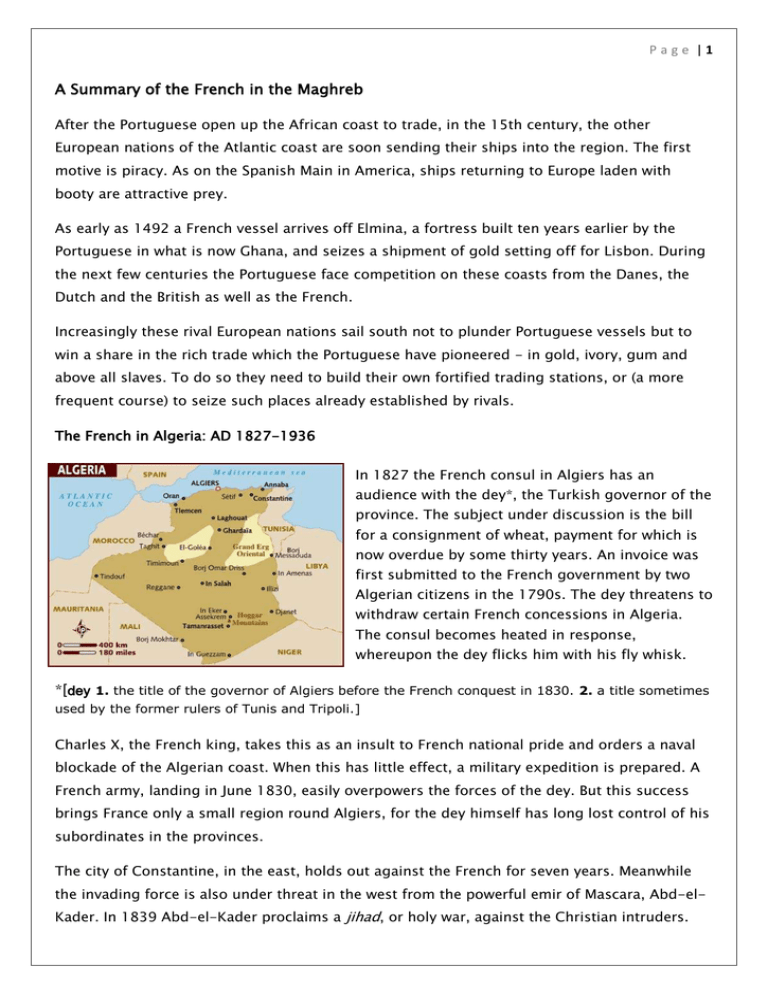
Page |1
A Summary of the French in the Maghreb
After the Portuguese open up the African coast to trade, in the 15th century, the other
European nations of the Atlantic coast are soon sending their ships into the region. The first
motive is piracy. As on the Spanish Main in America, ships returning to Europe laden with
booty are attractive prey.
As early as 1492 a French vessel arrives off Elmina, a fortress built ten years earlier by the
Portuguese in what is now Ghana, and seizes a shipment of gold setting off for Lisbon. During
the next few centuries the Portuguese face competition on these coasts from the Danes, the
Dutch and the British as well as the French.
Increasingly these rival European nations sail south not to plunder Portuguese vessels but to
win a share in the rich trade which the Portuguese have pioneered - in gold, ivory, gum and
above all slaves. To do so they need to build their own fortified trading stations, or (a more
frequent course) to seize such places already established by rivals.
The French in Algeria: AD 1827-1936
In 1827 the French consul in Algiers has an
audience with the dey*, the Turkish governor of the
province. The subject under discussion is the bill
for a consignment of wheat, payment for which is
now overdue by some thirty years. An invoice was
first submitted to the French government by two
Algerian citizens in the 1790s. The dey threatens to
withdraw certain French concessions in Algeria.
The consul becomes heated in response,
whereupon the dey flicks him with his fly whisk.
*[dey 1. the title of the governor of Algiers before the French conquest in 1830. 2. a title sometimes
used by the former rulers of Tunis and Tripoli.]
Charles X, the French king, takes this as an insult to French national pride and orders a naval
blockade of the Algerian coast. When this has little effect, a military expedition is prepared. A
French army, landing in June 1830, easily overpowers the forces of the dey. But this success
brings France only a small region round Algiers, for the dey himself has long lost control of his
subordinates in the provinces.
The city of Constantine, in the east, holds out against the French for seven years. Meanwhile
the invading force is also under threat in the west from the powerful emir of Mascara, Abd-elKader. In 1839 Abd-el-Kader proclaims a jihad, or holy war, against the Christian intruders.
Page |2
Not until 1847 does he finally surrender. He is promised a safe conduct to a Muslim country.
Instead he spends the next five years in French gaols. With Algeria now under a reasonable
degree of control (though outbreaks of rebellion continue until the 1880s), the French
government sets in place the process of colonisation. European settlement is actively
encouraged. By the 1880s the European population of Algeria is more than 350,000. Half a
century later this figure has doubled. In the same period, from 1830 to the mid-20th century,
the Muslim population also increases greatly, from 3 million to about 9 million. As in any such
situation, the settlers ensure that economic and political power is exclusively theirs. And as
elsewhere, the underprivileged majority begins to make itself heard during the 20th century.
The early leaders of Algerian nationalism see a solution in integration rather than separation.
Muslim Algerians, they argue, should enjoy equal status with the settlers as French citizens.
Ferhat Abbas (a future president of an independent Algerian parliament) writes in 1931:
'Algeria is French soil and we are French Muslims.' In 1936 the French socialist government of
Léon Blum sees the force of this argument. The so-called Blum-Violette plan proposes that
21,000 Muslims should immediately have the vote on the same terms as European settlers. But
this provokes an outcry from the settlers in Algeria. The proposal is dropped. The problems of
the future, though postponed by World War II, are prefigured in this clash.
Tunisia as a French Protectorate: AD 1881-1934 French control over Tunisia, achieved in
1881, brings to an end several decades of
diplomatic jockeying between three colonial
powers, France, Britain and Italy. All three are
officially involved in the region from 1869.
The local dynasty of beys (technically subordinate
to the Turkish sultan but in practice independent)
have in recent decades spent lavishly to
modernise their country, using funds borrowed in
Europe. The programme, accompanied by
necessary attempts to increase taxes, creates profound local resentment. By 1869 it is clear
that the province is bankrupt. France, Britain and Italy are placed jointly, by international
agreement, in control of Tunisian finances.
This arrangement is inevitably a platform on which three rival colonial powers jockey and trade
for position. France and Britain stand together in 1871 when the Italians begin to press
vigorous claims (justified in the sense that Italy has more investment and more nationals
settled in Tunisia than either other contender).
Page |3
By 1878 France and Britain come to a quiet agreement that the British will allow Tunisia to be a
French sphere of influence in return for French acceptance of the recently established British
presence in Cyprus. This still leaves the Italians as the chief claimants for a colonial presence
in Tunisia, until the French make a pre-emptive strike in 1881. Using the pretext that some
Tunisian tribesmen have strayed into the neighbouring French colony of Algeria, a French army
of some 36,000 men is sent across the border. As they advance upon Tunis, the bey [same as
dey] decides it will be prudent to come to terms. The 1881 Treaty of Bardo (also known as Al
Qasr as Sa'id) guarantees French protection for the bey's territory and dynasty, but it also
limits his authority to internal affairs. All other aspects of Tunisian policy are henceforth to be
dealt with by the French. This sudden lapse into colonial status brings many material benefits
to Tunisia. But it provokes, through the following decades, a crescendo of resistance. The
Young Tunisian Party is formed in 1907 to agitate for Tunisian autonomy. In 1920 a more
aggressive group calling itself Destour ('constitution') puts forward a demand for full
independence. From 1922 Destour has the support of the bey. But the French, by a judicious
blend of repression and concessions, ensure that there is little progress. By 1934 the younger
nationalists are again impatient. They break away from Destour, calling themselves NeoDestour. This event brings into prominence a politician destined to play the central role in the
future relationship between France and Tunisia and then in the affairs of independent Tunisia.
The secretary-general of the new party is Habib Bourguiba.
France and Spain in Morocco: AD 1900-1912
The process by which Morocco drifts into the colonial care of
France (and of Spain, in the northern regions) provides a
notable example of how the European powers jockey for
position in Africa.
In 1900 France and Italy make a secret agreement assigning
Morocco to France and Libya to Italy. In 1902 a similar
arrangement between France and Spain provides for the
proposed division between them of Moroccan territory. In
1904 France and Britain make a pact: Britain will allow France
freedom of action in Morocco (provided that the coast opposite Gibraltar is not fortified) in
return for France's acceptance of Britain's role in Egypt.
Meanwhile, as these arrangements are being made round polished tables, Morocco is still
ostensibly an independent country ruled, albeit inefficiently, by its own Alaouite dynasty of
sultans (on the throne since capturing Fès in 1666).
Page |4
The colonial consensus, amicably agreed between France, Italy, Spain and Britain, is rudely
interrupted in 1905 when the German emperor William II makes a flamboyant and provocative
visit to Tangier, Morocco's most international city. Ostensibly visiting the local community of
German merchants, he uses the occasion to emphasize that Morocco's independence must be
maintained. The diplomatic flurry caused by this intervention results in a conference held in
Algeciras in 1906. With the active encouragement of the internationally minded US president,
Theodore Roosevelt, representatives of the European powers and the USA gather to discuss
France's relationship with Morocco.
All the powers except Austria-Hungary side with France rather than Germany. The conference
affirms the independence of the sultan of Morocco, but at the same time puts in place
international supervision of his affairs with the leading role taken by France. This is
tantamount, in the long run, to accepting the region as a French colony.
Outbreaks of unrest in Morocco soon make necessary the posting of more French troops, thus
increasing the degree of French control. There is a brief international crisis in 1911 when the
Germans send a gunboat to Agadir, but the situation is defused in the fashion of the time.
France cedes some territory in central Africa to Germany's colony of Cameroon. In return
Germany accepts France's role in Morocco.
By 1912 the sultan is powerless to resist this gradual encroachment on his sovereignty. He
signs the treaty of Fès, accepting a French protectorate over his entire country - except such
regions as the French may themselves decide to allocate to Spain, in recognition of Spanish
interests on the Mediterranean coast.
In a separate agreement, later in 1912, France and Spain settle this issue. Spain becomes the
colonial power for approximately the northern tenth of the country, including its own historic
enclaves of Melilla and Ceuta (in Spanish hands since 1497 and 1580 respectively). It is
proposed that Tangier should become a neutral port with an international administration, but
the onset of World War I delays the implementation of this.
The effect of the agreements of 1912 is that Morocco becomes, for four decades, a region
divided into two very different colonies, French and Spanish, each in many ways more closely
linked to the colonial power than to each other.
Citizenship and independence in French Africa. 1946-60
Under the new constitution of the fourth republic, passed in 1946, France's colonial subjects in
Africa are given the status of French citizens. The immediate difference is not great, since the
colonial administration in each territory remains much the same (though with the addition now
Page |5
of an elected territorial assembly). But in political terms the change is enormous. Each colony
now also elects deputies to the national assembly in Paris.
A post-war generation of leaders in French Africa grows up with intimate experience of the
French political system and with close friendships in France. Known as the French Union, this
new relationship with the colonies is a subtle first step towards a post-colonial future. But this
concession is not enough to stifle demands for full independence. In the 1950s these become
vociferous in France's North African colonies, leading to a crisis which coincidentally brings
freedom to French West Africa and French Equatorial Africa. The Algerian crisis of 1958 brings
de Gaulle to power. The new constitution of his fifth republic offers the colonies a choice - to
sever immediately all links with France, or to remain members of the French Union (now
renamed the French Community) with the prospect of a more gradual move towards
independence.
Of the twelve colonies in French West Africa and French Equatorial Africa, only Guinea votes in
the 1958 referendum to leave the French Community. But freedom for the others follows more
quickly than might have been expected. They all win internal autonomy during 1958-9 and full
independence in 1960.
The reason is that the French government needs to focus on the much more dangerous
situation confronting it in Algeria, where a dramatic conflict between Algerian nationalists and
French settlers becomes extremely tense during the late 1950s. The coming crisis has been all
too evident since 1945.
Nationalism and reaction in Algeria: AD 1945-1958
The demands of Algerian nationalism become unmistakable immediately after the end of the
war in Europe. In May 1945 demonstrators carrying Algerian Nationalist flags appear at victory
celebrations in the town of Sétif.
Scuffles with the police spark an impromptu uprising in which eighty-eight French settlers are
killed. Subsequent French reprisals result in at least 1500 Muslim deaths (the official French
figure), though other estimates place the death toll as high as 10,000.
In the aftermath of this crisis the National Assembly in Paris passes, in 1947, a Statute of
Algeria. This makes provision for an Algerian assembly, with Muslims forming part of the
electorate. The assembly is duly elected, and there is much talk of wide-ranging reforms in the
administration of the colony.
Several years later the delegates have delivered little in the way of effective legislation, when
Algerian life is suddenly transformed by a wholly unexpected uprising. During the night of 31
Page |6
October 1954 several coordinated terrorist attacks are carried out on French police and
military establishments. A manifesto issued on November 1 declares them to be the work of
the recently formed FLN (Front de Libération Nationale), stating also that the political aim of
the FLN is a fully independent Algeria. Every resident in the country is promised citizenship of
the proposed new republic, with full rights, if willing to adopt Algerian nationality. Terrorist
violence and French reprisals now become an established pattern in Algeria. There is a vast
build up of French troops, and the army forcibly resettles some two million villagers to try and
deprive the FLN of rural support.
Meanwhile the FLN, joined by nearly all the other Algerian nationalist groups, establishes an
extremely sophisticated government in exile, first in Cairo then in Tunis. Diplomatic
representation is maintained at the UN and in friendly capitals around the world. From
September 1958 this body is known as the GPRA (Gouvernement Provisoire de la République
Algérienne), with the veteran nationalist Ferhat Abbas serving as prime minister.
A few months earlier the Algerian crisis has caused a major political upheaval within France
itself - as a result of direct action by the settlers (known as the pieds-noirs, black feet). In May
1958 angry French Algerians become alarmed that the government in Paris may come to terms
with the FLN. They seize government buildings in Algiers and establish a Committee of Public
Safety to ensure that Algeria remains French. Senior officers of the French army in Algeria side
with the insurgents, while right-wing groups in Paris become equally agitated. With the danger
of nation-wide disturbances, or even perhaps civil war, there is clearly need for a change of
government. A French general in Algeria expresses the mood of the moment, and the apparent
best hope for the pieds-noirs, when he declares: 'We appeal to General de Gaulle to take the
leadership of a Government of Public Safety.'
De Gaulle's moment: AD 1958
Charles de Gaulle, the war hero, waiting in retirement for his country's call, drives a hard
bargain when the moment comes. He will resume the leadership of the nation only if he is
given unrestricted powers for a period of six months and the authority to draft a new
constitution for a fifth French republic. On 2 June 1958 the national assembly accepts his
terms.
De Gaulle turns his attention first to the crisis which has caused his return to power. On June 4
he visits Algiers, to be received by an ecstatic crowd of settlers who greet him as their saviour.
But as they listen to his speech, from the balcony of Government House, their enthusiasm
becomes muted. Far from taking the expected right-wing line, De Gaulle talks of equal rights
for Europeans and Muslims. He praises the Algerian nationalists as courageous fighters, and
Page |7
holds out the prospect of an amnesty. 'To these men I, de Gaulle, open the door of
reconciliation.'
But the immediate next step is the preparation of a new constitution and the holding of a
referendum to win the approval of French citizens around the world. When the details are
announced, the constitution gives a much greater executive role to the president than under
the previous republic. He may even assume emergency powers in a crisis. The referendum is
ready for the voters in September 1958. In addition to seeking approval for the proposed
constitution, it asks voters in overseas territories whether they want to sever all links with
France or to be part of the French Community (known as La Communauté). All the territories
except Guinea vote to remain within La Communauté, and the constitution of the Fifth Republic
is approved by a large majority of 78% of the votes cast.
The most pressing task facing the new president remains Algeria. In the short term the
situation there becomes worse rather than better. But within four years it is solved, with the
precisely opposite result from the settlers' hopes of de Gaulle. The expected defender of
French Algeria presides over Algerian independence.
The thorny path to independence: AD 1959-1962
In September 1959 de Gaulle offers Algerians a choice once violence in the colony has ceased.
Within four years of the return of peace they are to have a free vote on three possible options
for their future: full political integration with France; association with France as an independent
entity; or complete secession as an independent nation.
The immediate effect of this proposal is even greater unrest in Algeria, where the settlers are
outraged at any suggestion that the link with France might be severed. In January 1960 there
are barricades in the streets of Algiers in an uprising which lasts ten days until the army, loyal
to de Gaulle, brings it to an end.
In April 1961 a more serious revolt is led by four senior generals in the French army in
Algeria. It too collapses after four days, when de Gaulle reacts with great firmness and
assumes special emergency powers. But the failed uprising prompts the final escalation of
terrorist violence in the colony.
Two of the generals surrender when the uprising fails. The other two, Raoul Salan and Edmond
Jouhaud, go underground to continue their resistance. They form the extremist OAS
(Organization de l'Armée Secrète) to engage in a campaign of terror against Muslims in Algeria
and against political targets in mainland France. In September 1961 an attempt is made to
assassinate de Gaulle. With FLN terrorist activity also continuing in Algeria, the colony by now
requires the permanent attention of some 500,000 troops. The only practical solution is
Page |8
discreetly acknowledged when the French government, in the autumn of 1961, begins secret
negotiations with the provisional Algerian government in Tunis (the GPRA). In March 1962 a
cease-fire is agreed at Évian-les-Bains, to be followed by a referendum on Algerian
independence. This agreement sparks off an immediate escalation of OAS terrorist activity, but
in April 1962 the people of France endorse the Évian terms with a 90% vote of approval. Two
weeks later the OAS leader, Raoul Salan, is captured in Algiers. During the summer of 1962
about three quarters of the French colonists flee from Algeria to France, leaving only some
250,000 (reduced by the end of the 1960s to fewer than 100,000).The departure of the
predominantly right-wing element among the settler population is reflected in the referendum
held in Algeria on 1 July 1962. Nearly six million votes are cast in favour of independence, less
than 17,000 against. Two days later de Gaulle formally recognises Algeria as an independent
nation. In October the new state becomes a member of the United Nations.
Source
http://www.historyworld.net/wrldhis/PlainTextHistories.asp?groupid=132&HistoryID=ab04&gt
rack=pthc
Map of Morocco
http://www.google.com.au/imgres?q=map+of+MOrocco+and+surrounding+countries&hl=en&gbv=2&biw=1094&
bih=602&tbm=isch&tbnid=qgwRjwARiTIzoM:&imgrefurl=http://www.veggiebyseason.com/2008_10_01_archive.
html&docid=3o4_0ZqwKhNQ_M&imgurl=http://2.bp.blogspot.com/_VkhOkO9zFjo/SQd-8mcGSoI/AAAAAAAABg/5BLtBoK6OfA/s400/Morocco_map.jpg&w=375&h=400&ei=9OEdT5DcNKGRiQfI3dzrDQ&zoom=1&iact=hc&vpx=
592&vpy=240&dur=52&hovh=232&hovw=217&tx=134&ty=153&sig=109866586690601387553&page=1&tbnh=1
28&tbnw=120&start=0&ndsp=18&ved=1t:429,r:9,s:0
Map of Tunisia
http://www.google.com.au/imgres?q=map+of+tunisia+and+surrounding+countries&hl=en&biw=1094&bih=602&
gbv=2&tbm=isch&tbnid=Jgs82NgalkDIM:&imgrefurl=http://www.lonelyplanet.com/maps/africa/tunisia/&docid=lGdZ67HLIWlcLM&imgurl=
http://www.lonelyplanet.com/maps/africa/tunisia/map_of_tunisia.jpg&w=466&h=350&ei=TOEdT5q3K62XiQev4L
XuDQ&zoom=1&iact=hc&vpx=793&vpy=139&dur=130&hovh=194&hovw=259&tx=195&ty=104&sig=1098665866
90601387553&page=1&tbnh=118&tbnw=155&start=0&ndsp=21&ved=1t:429,r:6,s:0
Map of Algeria
http://www.google.com.au/imgres?q=map+of+Algeria+and+surrounding+countries&hl=en&gbv=2&biw=1094&bi
h=602&tbm=isch&tbnid=x8cVfPgseV5SyM:&imgrefurl=http://www.sandraoffthestrip.com/2011/09/02/southafrican-mercenaries-and-algeria-aisha-gaddafi-baby-safiya-2-brothers-hannibal-mohammed-taken-to-algierswith-mrs-safiya-gaddafi/&docid=h3pECqBMG5J5rM&imgurl=http://www.sandraoffthestrip.com/wpcontent/uploads/map_of_algeria.jpg&w=466&h=350&ei=meMdT5vvE4qaiQeF2e3gDQ&zoom=1&iact=hc&vpx=2
32&vpy=185&dur=33&hovh=194&hovw=259&tx=152&ty=118&sig=109866586690601387553&page=1&tbnh=10
8&tbnw=144&start=0&ndsp=20&ved=1t:429,r:15,s:0
